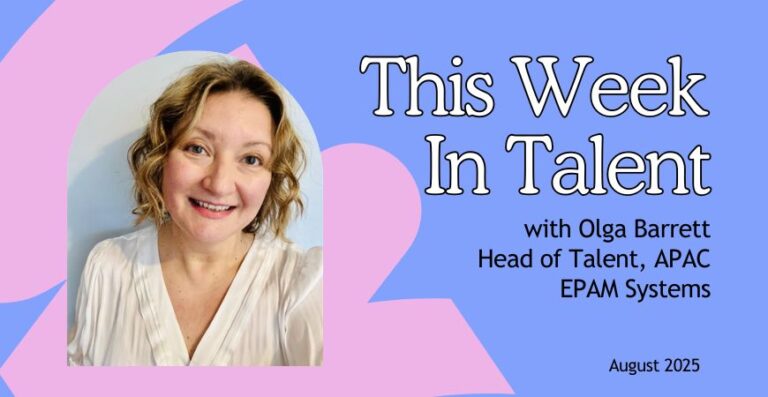Ever submitted a job application only to feel like it vanished into a black hole? You’re not alone! This common frustration was at the forefront of last week’s October Melbourne Talent Meetup (with Matt Woodard and team), where CX experts Steve Gard from Benchmarcx and Kylie Lewis shared insights on how a Customer Experience (CX) approach can transform recruitment and make candidates feel valued.
CX Obsession: Why It Matters
Since 2017, I’ve been captivated by the intersection of CX and Talent Acquisition, thanks to Joe Pine — the guy who literally wrote the book on the Experience Economy.His inspiring keynote for Qualtrics continues to fuel my passion (DM me and I’ll share the video).
At the meetup, we tackled a pressing issue: “I never hear back from my application.” The advice given? Understand how candidates feel and map their journey etc. Vital, no doubt. But I think there’s a powerful solution that deserves time in the spotlight which will work alongside that CX focus: closing job ads after 7 days.
Unearthing the Data Goldmine
Having led or worked with internal TA teams ranging from 30 to 600 recruiters (yes, 600 is not a typo) , I’ve had access to extensive Applicant Tracking System reports from large organizations in Australia, India, USA, China and beyond. One question always intrigued me: “When do successful candidates actually apply?“
The verdict? Successful candidates almost always apply within the first week of a job ad going live. This revelation compels us to rethink our approach: how can we leverage this insight to enhance both candidate and recruiter experience?
The Recruitment Conundrum
Let’s break down a typical recruitment scenario:
- The Fresh Job: A recruiter is assigned a new position, juggling multiple openings at once.
- The Ad Dilemma: They post the job ad while simultaneously searching for candidates. Ads typically run for a month or longer, sometimes with multiple refreshes.
- The Application Flood: Good candidates get shortlisted quickly, but as the ad remains open, and applications often continue to pour in.
Here’s the kicker: many applicants (who may also be your future customers) hear nothing back while recruiters are overwhelmed by new roles.
Putting my Theory to the Test
When I shared my past findings at the meetup, fellow TA leader Stefan Welack decided to put my theory to the test (the next day). The result from his high-tech firm revealed that successful candidates, on average, applied within 6 days—even though their ads were live for over 30!
I challenge you: check your data! You might find the same insight staring back at you.
Vintage is so hot right now: The 7-Day Rule
Back in the days of print recruitment, job ads had a short lifespan—often featured in weekly newspaper supplements with clear close dates and salary ranges. Today, including salary information in ads is increasingly relevant for equity reasons (just ask Natalie Flynn from equidi).
As a TA leader, here’s how you can implement a 7-day advertising strategy that won’t cost a thing but will yield significant benefits:
- Close Job Ads After 7 Days: Encourage your recruiters to pull down ads after just one week and include a firm close date. (you may run up against an advertising policy, but try it if you can).
- Set Clear Shortlist Dates: Collaborate with hiring managers to establish a shortlist timeline, providing candidates with clarity on when to expect feedback.
- Communicate Promptly: Notify those not shortlisted to avoid leaving candidates in limbo. Remember, you can always re-engage declined candidates later—but silence is a brand killer!
If you have ongoing hiring needs, think differently
If you’re grappling with ongoing hiring needs, ditch the constant ad refreshes and embrace a genuine talent pool strategy. Feel free to connect with Therefore Talent if you’re in Australia and we can help you develop one.
The Power of Change
What happens when you close a job ad after just 7 days instead of 30? In every TA team I’ve worked with, ad response makes up a single figure percentages of successful hires, yet they generate the majority of applications and workload.
By reducing the advertising window to 7 days, you can:
- Achieve the same or even better hiring results.
- Align expectations between candidates and hiring managers.
- Lighten the administrative load for recruiters.
- Maintain a lean candidate database—great news for your chief data officer.
- Eliminate the frustration of candidates “never hearing back.”
The result? You’ll disappoint fewer applicants, and your brand manager will thank you for it! You’ll also make direct and indirect savings (money and time) that you can re-invest in CX.
By adopting this “brilliant basic” of closing job ads after 7 days, you’ll not only streamline your process but it will help create the space needed for you to create remarkable candidate experiences. Meaning you can make candidates feel valued and excited about engaging with your brand—regardless of the outcome!
Connect with Paul on LinkedIn







